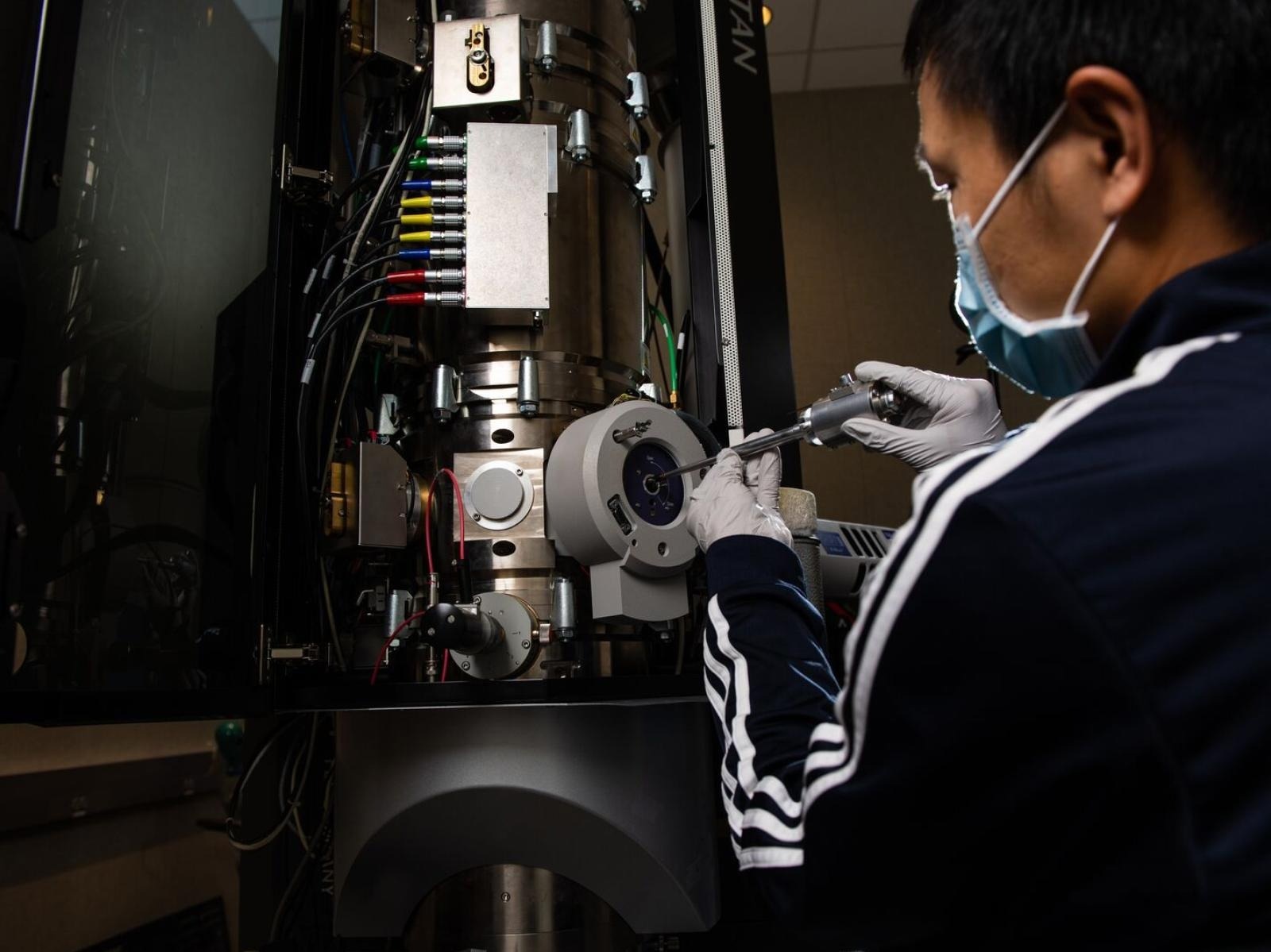For decades, experts have thought that performance loss is caused by the unavoidable filmy accumulation on electrodes within rechargeable batteries. It is now clear that the perspective is backward.
 Battery research scientist Yaobin Xu inserts a sample into a transmission electron microscope to examine the function of a rechargeable battery. Image Credit: Andrea Starr for Pacific Northwest National Laboratory
Battery research scientist Yaobin Xu inserts a sample into a transmission electron microscope to examine the function of a rechargeable battery. Image Credit: Andrea Starr for Pacific Northwest National Laboratory
The formation of mossy or tree-like structured lithium metal deposits on battery electrodes is a secondary effect rather than the source of performance degradation. Nature Energy published the first direct measurement of the electrical characteristics at the interface between the solid electrode and the liquid electrolyte within a rechargeable battery.
The research, headed by a team at the Department of Energy’s Pacific Northwest National Laboratory, demonstrates that the so-called solid electrolyte interphase (SEI) is not an electronic insulator as previously assumed. Instead, it acts like a semiconductor. The study addresses a long-standing enigma about how SEI works electrically during battery operation.
The discoveries have immediate implications for developing longer-lasting batteries by fine-tuning the physical and electrochemical characteristics of the liquid electrolyte, which is commonly referred to as an operational battery’s blood supply.
A higher rate of electrical conductance induces a thicker SEI with intricate solid lithium forms, ultimately leading to inferior battery performance.
Chongmin Wang, Study Co-Lead, Laboratory Fellow, Pacific Northwest National Laboratory
Micro-Sized Battery Upends Assumptions About How Rechargeable Batteries Work
Researchers are interested in this SEI layer, which is thinner than a sheet of tissue paper, because of its significant impact on battery performance. This filmy mosaic selectively allows charged lithium ions to cross during discharge and regulates the movement of electrons that provide power to the battery.
The SEI occurs during the first charging cycle of a new battery and ideally remains stable throughout the battery’s estimated lifespan. An examination inside an old rechargeable battery, on the other hand, frequently reveals a significant deposit of solid lithium on the negative electrodes.
Battery experts believe that this accumulation is what causes the performance reductions. An inability to perform measurements to establish cause and effect has contributed to this guesswork.
Wang, PNNL’s Battery Materials and Systems Group materials scientist Wu Xu, co-first authors Yaobin Xu and Hao Jia, and their colleagues at PNNL, Texas A&M University, and Lawrence Berkeley National Laboratory addressed this issue using an innovative method to directly measure electrical conduction across the SEI in an experimental system.
The researchers used transmission electron microscopy in conjunction with nanoscale manipulation of microfabricated metal needles within the microscope. The electrical characteristics of the SEI layer produced on either copper or lithium metal were then tested using four different types of electrolytes.
The observations of the study indicated that when the voltage in the battery grows, the SEI layer releases electrons in all situations, making it semi-conductive.
Findings Suggest Carbon-Containing Molecules Leak Electrons, Reducing Battery Life
They sought to know which components of the chemically complex SEI were responsible for the electron leakage after they had recorded this semiconductor-like behavior, which had never been directly witnessed before.
We found that the carbon-containing organic components of the SEI layer are prone to leaking electrons.
Wu Xu, Chief Scientist, Electrochemical Materials and Systems Group, Pacific Northwest National Laboratory
The researchers determined that reducing the organic components in SEI would allow the batteries to last longer.
Wang added, “Even slight variations of the rate of conduction through the SEI can result in dramatic differences in efficiency and battery cycling stability.”
Peiyuan Gao, Xia Cao, Phung M. L. Le, Mark H. Engelhard, Shuang Li, and Ji-Guang Zhang from PNNL contributed to the study. The research was funded by the DOE Office of Energy Efficiency and Renewable Energy’s Office of Vehicle Technologies and the US-Germany Cooperation on Energy Storage.
The imaging and electrical analysis were carried out at PNNL’s Environmental Molecular Sciences Laboratory, a national scientific user facility financed by the DOE’s Office of Biological and Environmental Research. The Molecular Foundry, situated at Lawrence Berkeley National Laboratory and financed by the DOE Office of Science, Office of Basic Energy Sciences, conducted some characterization work.
Journal Reference:
Xu, Y., et al. (2023) Direct in situ measurements of electrical properties of solid–electrolyte interphase on lithium metal anodes. Nature Energy. doi:10.1038/s41560-023-01361-1